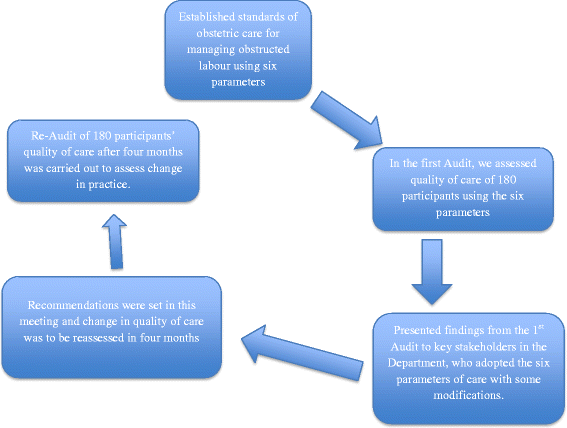Improving the quality of obstetric care for women with obstructed labour in the national referral hospital in Uganda: lessons learnt from criteria based audit
- PMID: 27402019
- PMCID: PMC4940986
- DOI: 10.1186/s12884-016-0949-1
Improving the quality of obstetric care for women with obstructed labour in the national referral hospital in Uganda: lessons learnt from criteria based audit
Abstract
Background: Obstructed labour remains a major cause of maternal morbidity and mortality whose complications can be reduced with improved quality of obstetric care. The objective was to assess whether criteria-based audit improves quality of obstetric care provided to women with obstructed labour in Mulago hospital, Uganda.
Methods: Using criteria-based audit, management of obstructed labour was analyzed prospectively in two audits. Six standards of care were compared. An initial audit of 180 patients was conducted in September/October 2013. The Audit results were shared with key stakeholders. Gaps in patient management were identified and recommendations for improving obstetric care initiated. Six standards of care (intravenous fluids, intravenous antibiotics, monitoring of maternal vital signs, bladder catheterization, delivery within two hours, and blood grouping and cross matching) were implemented. A re-audit of 180 patients with obstructed labour was conducted four months later to evaluate the impact of these recommendations. The results of the two audits were compared. In-depth interviews and focus group discussions were conducted among healthcare providers to identify factors that could have influenced the audit results.
Results: There was improvement in two standards of care (intravenous fluids and intravenous antibiotic administration) 58.9 % vs. 86.1 %; p < 0.001 and 21.7 % vs. 50.5 %; P < 0.001 respectively after the second audit. There was no improvement in vital sign monitoring, delivery within two hours or blood grouping and cross matching. There was a decline in bladder catheterization (94 % vs. 68.9 %; p < 0.001. The overall mean care score in the first and second audits was 55.1 and 48.2 % respectively, p = 0.19. Healthcare factors (negative attitude, low numbers, poor team work, low motivation), facility factors (poor supervision, stock-outs of essential supplies, absence of protocols) and patient factors (high patient load, poor compliance to instructions) contributed to poor quality of care.
Conclusion: Introduction of criteria based audit in the management of obstructed labour led to measurable improvements in only two out of six standards of care. The extent to which criteria based audit may improve quality of obstetric care depends on having basic effective healthcare systems in place.
Keywords: Criteria-based audit; Obstructed labour; Quality improvement; Quality of obstetric care; Uganda.
Figures
Similar articles
-
Improving Standards of Care in Obstructed Labour: A Criteria-Based Audit at a Referral Hospital in a Low-Resource Setting in Tanzania.PLoS One. 2016 Nov 28;11(11):e0166619. doi: 10.1371/journal.pone.0166619. eCollection 2016. PLoS One. 2016. PMID: 27893765 Free PMC article.
-
A criterion based audit of the management of obstructed labour in Malawi.Arch Gynecol Obstet. 2009 May;279(5):649-54. doi: 10.1007/s00404-008-0786-1. Epub 2008 Sep 9. Arch Gynecol Obstet. 2009. PMID: 18779971
-
Improved quality of management of eclampsia patients through criteria based audit at Muhimbili National Hospital, Dar es Salaam, Tanzania. Bridging the quality gap.BMC Pregnancy Childbirth. 2012 Nov 21;12:134. doi: 10.1186/1471-2393-12-134. BMC Pregnancy Childbirth. 2012. PMID: 23170817 Free PMC article.
-
Obstructed labour.Br Med Bull. 2003;67:191-204. doi: 10.1093/bmb/ldg018. Br Med Bull. 2003. PMID: 14711764 Review.
-
Audit as a tool for improving obstetric care in low- and middle-income countries.Best Pract Res Clin Obstet Gynaecol. 2024 Jun;94:102477. doi: 10.1016/j.bpobgyn.2024.102477. Epub 2024 Apr 3. Best Pract Res Clin Obstet Gynaecol. 2024. PMID: 38581883 Review.
Cited by
-
Evaluation of criterion-based audit in improving quality of neonatal birth asphyxia care at Balaka district hospital in Malawi.Matern Health Neonatol Perinatol. 2024 Nov 4;10(1):21. doi: 10.1186/s40748-024-00191-7. Matern Health Neonatol Perinatol. 2024. PMID: 39491034 Free PMC article.
-
Management of preterm birth using protocols in a low resource setting.PLoS One. 2023 Apr 25;18(4):e0284894. doi: 10.1371/journal.pone.0284894. eCollection 2023. PLoS One. 2023. PMID: 37098025 Free PMC article.
-
Partograph utilization as a decision-making tool and associated factors among obstetric care providers in Ethiopia: a systematic review and meta-analysis.Syst Rev. 2020 Nov 3;9(1):251. doi: 10.1186/s13643-020-01505-4. Syst Rev. 2020. PMID: 33143728 Free PMC article.
-
What is the quality of the maternal near-miss case reviews in WHO European Region? Cross-sectional study in Armenia, Georgia, Latvia, Republic of Moldova and Uzbekistan.BMJ Open. 2018 Apr 12;8(4):e017696. doi: 10.1136/bmjopen-2017-017696. BMJ Open. 2018. PMID: 29654004 Free PMC article.
-
Multiple electrolyte derangements among perioperative women with obstructed labour in eastern Uganda: A cross-sectional study.PLOS Glob Public Health. 2023 Jun 12;3(6):e0002012. doi: 10.1371/journal.pgph.0002012. eCollection 2023. PLOS Glob Public Health. 2023. PMID: 37307269 Free PMC article.
References
-
- Adhikari S, Dasgupta M, Sanghamita M. Management of obstructed labour: a retrospective study. J Obstet Gynecol India. 2005;55:48–51.
-
- Hunyinbo K, Fawole A, Sotiloye O, Otolorin E. Evaluation of criteria-based clinical audit in improving quality of obstetric care in a developing Country hospital. Afr J Reprod Health. 2008;12(3):59–70. - PubMed
Publication types
MeSH terms
Substances
LinkOut - more resources
Full Text Sources
Other Literature Sources
Medical


